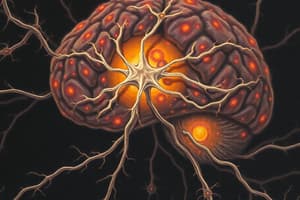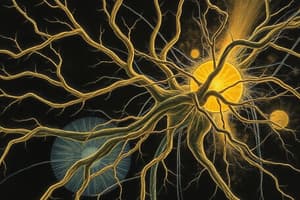Podcast
Questions and Answers
What is a primary function of the nervous system?
What is a primary function of the nervous system?
- Transport nutrients throughout the body
- Transmit signals between different parts of the body (correct)
- Store fat for energy
- Regulate hormonal balance
Which of the following structures is a part of the central nervous system?
Which of the following structures is a part of the central nervous system?
- Spinal cord
- Both A and C (correct)
- Peripheral nerves
- Brain
What role do neurons play within the nervous system?
What role do neurons play within the nervous system?
- They store energy
- They produce hormones
- They transmit electrical signals (correct)
- They divide and replicate often
Which type of neuron is responsible for transmitting signals from the brain to muscles?
Which type of neuron is responsible for transmitting signals from the brain to muscles?
What is the significance of myelin sheaths?
What is the significance of myelin sheaths?
Which part of the nervous system is responsible for the 'fight or flight' response?
Which part of the nervous system is responsible for the 'fight or flight' response?
Which of the following best describes the function of glial cells?
Which of the following best describes the function of glial cells?
What is a key characteristic of the peripheral nervous system?
What is a key characteristic of the peripheral nervous system?
Which component is primarily responsible for transmitting signals in the nervous system?
Which component is primarily responsible for transmitting signals in the nervous system?
What role do neurotransmitters play in the nervous system?
What role do neurotransmitters play in the nervous system?
Which of the following statements about the nervous system is true?
Which of the following statements about the nervous system is true?
Which neurotransmitter is primarily associated with the regulation of mood and emotions?
Which neurotransmitter is primarily associated with the regulation of mood and emotions?
What best describes the role of myelin in the nervous system?
What best describes the role of myelin in the nervous system?
Which of the following is a key function of glial cells?
Which of the following is a key function of glial cells?
Which type of neuron is responsible for carrying signals from sensory receptors to the central nervous system?
Which type of neuron is responsible for carrying signals from sensory receptors to the central nervous system?
What is the primary function of the somatic nervous system?
What is the primary function of the somatic nervous system?
What type of cells are responsible for supporting and protecting neurons?
What type of cells are responsible for supporting and protecting neurons?
Which part of the neuron is primarily responsible for receiving signals?
Which part of the neuron is primarily responsible for receiving signals?
Which neurotransmitter is mainly involved in muscle contraction?
Which neurotransmitter is mainly involved in muscle contraction?
Which structure is mainly involved in the coordination of voluntary movements?
Which structure is mainly involved in the coordination of voluntary movements?
Which protective layer surrounds the brain and spinal cord?
Which protective layer surrounds the brain and spinal cord?
What is the role of the autonomic nervous system?
What is the role of the autonomic nervous system?
Which part of the nervous system is responsible for initiating the 'rest and digest' response?
Which part of the nervous system is responsible for initiating the 'rest and digest' response?
Flashcards
Nervous System
Nervous System
The complex network of nerves and cells that transmits information throughout the body.
Neurons
Neurons
Specialized cells that transmit information throughout the nervous system.
Synapse
Synapse
The junction between two neurons where signals are transmitted.
Impulse Transmission
Impulse Transmission
Signup and view all the flashcards
Neurotransmitters
Neurotransmitters
Signup and view all the flashcards
Module 12
Module 12
Signup and view all the flashcards
Brain
Brain
Signup and view all the flashcards
YouTube Videos
YouTube Videos
Signup and view all the flashcards
Time To Climb
Time To Climb
Signup and view all the flashcards
Lesson Modules
Lesson Modules
Signup and view all the flashcards
Bodily Functions
Bodily Functions
Signup and view all the flashcards
What is the nervous system?
What is the nervous system?
Signup and view all the flashcards
What are nerve cells called?
What are nerve cells called?
Signup and view all the flashcards
What is a synapse?
What is a synapse?
Signup and view all the flashcards
What are neurotransmitters?
What are neurotransmitters?
Signup and view all the flashcards
What's the role of the brain?
What's the role of the brain?
Signup and view all the flashcards
What does the Brain do?
What does the Brain do?
Signup and view all the flashcards
What are YouTube videos used for in this lesson?
What are YouTube videos used for in this lesson?
Signup and view all the flashcards
Study Notes
Nervous System Overview
- The nervous system is comprised of two cell types: neurons and glial cells.
- Neurons are the functional units responsible for communication through electrical signals.
- Glial cells are support cells that enable neuron function.
- Neurons are polarized cells with dendrites receiving signals, which are then passed to the cell body and propagated along the axon to terminal ends that synapse with other cells.
- Myelin speeds signal conduction.
Central and Peripheral Nervous Systems
- Central Nervous System (CNS) = brain and spinal cord.
- Peripheral Nervous System (PNS) = nerves.
- The brain is located in the cranial cavity of the skull, and the spinal cord, in the vertebral canal of the vertebral column.
- The peripheral nervous system is so named because it extends beyond the brain and spinal cord.
Functional Classification of Nervous Systems
- Sensory functions receive information from the environment.
- Motor functions react to sensory information.
- Integration functions coordinate between sensory and motor functions.
Types of Neurons
- Sensory (afferent) neurons carry impulses from the periphery to the CNS.
- Motor (efferent) neurons carry signals from the CNS to body systems.
- Interneurons provide connections between afferent and efferent neurons, most abundant.
Sensory Function: The Sensation
- Sensation refers to receiving information about the environment.
- Stimuli (singular = stimulus) are these sensations.
- Sensory information travels to the CNS via afferent (sensory) branches of the PNS.
- Somatic sensory refers to sensations outside the body, while visceral sensory refers to sensations from within the body.
Motor Function: The Response
- Responses occur in effector organs (such as muscles or glands) in reaction to sensory stimuli.
- Motor (efferent) branches of PNS transmit signals from the CNS to effector organs
- Somatic motor neurons control voluntary muscle responses; autonomic motor neurons control involuntary responses in cardiac or smooth muscles or glands.
Integration: Coordination between Sensation and Response
- Stimuli are detected by sensory structures (somatic or visceral sensory).
- Through afferent nerves they are communicated to CNS.
- In the CNS, information from stimuli is integrated.
- A motor neuron in the CNS is stimulated and directs the effector organ.
- The process by which sensory information is processed and a motor response is generated is called integration.
Nervous System Cells
- Neurons are the primary functional units in the nervous system, classified by the direction in which they conduct impulses.
- They are generators and conductors of nerve impulses.
- They employ electrochemical processes involving sodium and potassium ions to change the electrical potential of neuron fluid.
- Glial cells provide support to neurons.
- They have connective tissue supporting functions within the CNS.
Brain Review Parts
- Brain is divided into two hemispheres connected by a bundle of nerves (corpus callosum)
- Each hemisphere controls the opposite side of the body
- The three broad functions of the CNS are to take in sensory information, process the information, and send out motor signals.
Nervous System
- The nervous system is comprised of the central and peripheral nervous systems.
- The central nervous system (CNS) consists of the brain and spinal cord. The peripheral nervous system (PNS) consists of nerves.
- The three broad functions of CNS are to take in sensory information, process the information, and send out motor signals.
- The PNS conveys information between the CNS and the rest of the body..
Spinal Nerves
- Spinal nerves carry information to and from the spinal cord
- 31 pairs (8 cervical, 12 thoracic, 5 lumbar, 5 sacral and 1 coccygeal)
- Spinal nerves are named for the vertebra immediately below their exit point from the spinal canal.
Clinical Module: Ischemic CNS Injury
- Ischemia, inadequate perfusion, results in impaired oxygenation and potential tissue death.
- Ischemia is caused by blood vessel occlusion (thrombus or local hemorrhage)
- Brain tissue is quickly damaged as it does not store oxygen or nutrients.
Clinical Module: Hemorrhagic Stroke
- Hemorrhagic stroke is caused by blood vessel integrity disruptions (ruptured aneurysm or arteriovenous malformation, or trauma).
- Blood leaks into the brain tissue or subarachnoid space.
- Intracerebral hemorrhage involves bleeding into brain tissue itself; subarachnoid hemorrhage involves bleeding into the subarachnoid space.
Protective Structures of the CNS: Meninges
- Meninges - layered unit of membranous connective tissue.
- Comprised of three layers; dura mater, arachnoid mater, and pia mater. Cranial nerves are attached to the brain
- Primary sensory and motor functions of the head and neck
- There are twelve cranial nerves.
Studying That Suits You
Use AI to generate personalized quizzes and flashcards to suit your learning preferences.





